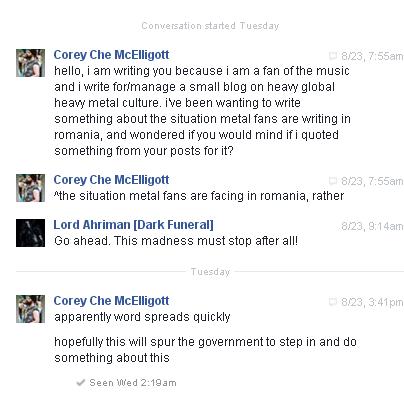Introduction
9 years ago this month (August 24th, 2007), a terrible tragedy in England resonated throughout the sub-cultural (and mainstream) communities around the world.
Sophie Lancaster and her boyfriend (Robert Maltby) were targeted by a group of thugs and brutally attacked. There was no provocation – they were chosen because of the way they dressed (as I understand it they were part of the English Goth community).
Although Goths and Metalheads are separate and distinct cultures, there is a good deal of crossover between them (as there is with a lot of sub-cultures). Enough crossover, in fact, that both the young men committing the criminal act and the witness who called the paramedics referred to them (among other things) as “moshers” (a pejorative term to refer to goths, metalheads, and other similar looking subscribers to sub-cultures in England, as I understand it).
And this wasn’t an isolated incident. I’m not saying anything sensationalist here – heavy metal and other subcultures aren’t under constant attack. But when you participate in any subculture/counter culture, it’s good to remember that there’s going to be a broad spectrum of reaction from the mainstream cultures (and other subcultures, for that matter) that’s going to include (but isn’t limited to) physical retaliation and violence.
Given the Dionysian, Hedonistic, Anti-Social (not Asocial, as most people tend to define it) cultural tendencies metalheads, goths, punks, emo kids, scene kids, etc tend to share – it’s not surprising that there is often a negative reaction from a predominantly Apollonian mainstream culture.
So, while I have absolutely no idea whether or not Sophie Lancaster and her boyfriend actually listened to heavy metal or were part of the subculture – it’s a moot point. To someone who comes from a place outside of these cultures – they’re all one and the same. Ben Moores (a teenage metalhead) was attacked in a similar manner to Sophie 5 years later.
An American Perspective to Illustrate a Greater Point
And I have to admit, as an American Metalhead my knowledge is inherently biased towards my own experience and those of my peers. For example – I’m much more familiar with the cultural persecution of metalheads in America from the Satanic Panic of the 1980’s and early 1990’s and the subsequent cultural fallout.
Judas Preist and Ozzy Osbourne were both put on trial after young men who were fans of their music committed suicide. Christian youth behavioral modification camps capitalized on the satanic panic to “de-metalize” or “de-punk” rebellious youth. American police were trained to recognize and discriminate against metalheads. Censorship as a part of a multi-faceted attack on heavy metal that includes religious moral and political concerns from the dominant culture is nothing new. (Sound of the Beast, by Ian Christe, chapter 17)
When the Columbine tragedy occurred, mainstream culture and the media were quick to associate the young men’s association to heavy metal as the culprit.
Three teenage boys (dubbed the West Memphis Three) were scapegoated in a brutal murder case of three young boys on circumstantial evidence and held for 18 years. Even after they were freed (they were obviously innocent – this was the subject of several documentaries) – they had to agree to a plea deal where the state admitted no wrongdoing.
After the brutal rape and murder of Elyse Pahler, her parents (unsuccessfully) sued Slayer twice as the cause of the horrid attack.
In Arizona, when Congresswoman Gabrielle Giffords was shot – the media was quick to point out Jared Loughner’s association with heavy metal music through his love of a single Drowning Pool song.
And, although marginalized, the demonization of heavy metal and it’s followers by the church continues in the United States to this day.
What Does this all Mean?
When a mainstream/dominant culture demonizes or vilifies a smaller sub-group on a large-scale/macro level, there tend to be individual manifestations of this within the interactions between members of those cultures on a micro/individual level.
If the church and the government in the United States had not brought mainstream culture to a state of panic concerning heavy metal in the United States (elected representatives publicly speaking against the music, media demonizing fans and musicians alike, congressional hearings spurred by the PMRC resulting in the censorship and subsequent economic sanctions that occurred as a result, etc), there most likely wouldn’t have been such a tendency towards blaming heavy metal for societal ills on an individual/micro level.
Applying this to the situation in England, I’m guessing that greater cultural norms had a significant impact on the social landscape of the country. Considering that the pejorative term “mosher” even exists to describe anyone who is a member of the subcultures being discussed in this article – I’d say that’s a pretty safe bet. The negative mainstream cultural connotations attributed to metalheads and goths (and others) can be seen as both an indirect and a direct cause of these brutal hate crimes. This sort of hatred didn’t come out of thin air – it’s a logical conclusion that a similar societal pattern existed in England to the one in the United States that led to where we are today.
So, the legacy of Sophie Lancaster is best exemplified through the Sophie Lancaster Foundation – which is focused on creating respect for and understanding of subcultures within communities.
Moving Forward
I would argue that there is a responsibility on behalf of the global community of such subcultures (metalheads included) to not only remember such horrible events, but to recognize societal patterns that have proven historically to lead to this sort of violence and intolerance.
Because it’s not limited to England and the United States (or Christianity) – I recently wrote a piece dealing with a situation in Romania where the church has caused a stir in the local community.

After receiving the blessing (sic) of Lord Ahriman of Dark Funeral to use some of what he was saying/reporting on in the area, I wrote a piece detailing how the a Russian Orthodox Priest had petitioned the local government in protest of Dark Funeral’s recent concert in the area. the government, in turn, issued a vocal statement that they would allow the priest to decide who did or did not play at public venues in the area.
The problem with this is that in similar instances across the globe where a particularly fundamentalist religious population enlists and is granted government aide to strip a group of citizens of their rights leads to a societal marginalization that can (and has) led to individual incidents of violence against people of that particular group. And metal culture has been proven to be particularly susceptible to this around the world.
Whether it’s in Africa, South America, Latin America, the US, Europe, Russia, China, Malaysia, India, or anywhere else on the globe – it’s good for people to be aware that this sort of thing can and does happen.
Metalhead response to what happened to Sophie Lancaster has been a global phenomenon – it got a dialogue going where it was urgently needed, there have been metal festivals dedicated to her, Bloodstock Open Air has a stage dedicated to her, charity shows for the Sophie Lancaster foundation, a charity album, and most importantly – social change via legislation that classifies subculture abuse as a hate crime. And it’s something that, almost a decade later, still resonates with people on a very human level.
I think it’s safe to say this is, globally, something worth supporting.


August 27, 2016 at 8:34 pm
Reblogged this on Kerberos616.
LikeLike